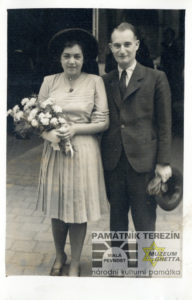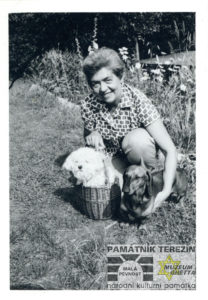Lisa Miková was born in 1922 into a Prague family of assimilated Jews. According to her own narrative, even though she visited the synagogue with her mother and her family celebrated some Jewish feasts, during the Christmas holiday they decorated a Christmas tree just as the families of Lisa´s friends. In her childhood, Lisa perceived no differences between herself and her non-Jewish pals whatsoever, but that was to change radically in the future.
Lisa’s father built his own business in Prague and her mother helped him out. Lisa spent a happy and harmonious childhood. She learnt to speak several foreign languages including Spanish. At the time when emigration was still possible for the family her father did not want to leave the country. In Prague he used to meet Jews coming from the Sudetenland who urged him to leave Czechoslovakia: You have to go away, you’ve got to flee! You mustn’t stay! But my father was a convinced Czech… and said: Nothing like that can happen in our country,1 Lisa later recollected his words.
All hopes for freedom and escape from Czechoslovakia were then dashed by the events following March 15, 1939. For Lisa and her family this particular date spelt the end of all hopes for life in freedom. The borders were closed and just like other Jews in the Protectorate Lisa´s family too came to know the cruel impact of the steadily escalating anti-Jewish measures. Father was forced to pass his business into the Nazi hands and, for a time, he served as an employee of the new owner. At the same time, his access to his own bank accounts was blocked. We wanted to emigrate but nobody wanted to take us,2 says Mrs. Miková.
Lisa and her family were deported to Terezín on January 31, 1942, the day of Lisa’s 20th birthday. Thanks to her artistic talents she was given a job of a draftswoman in the Technical Office where she met not only distinguished Terezín painters, whose drawings have preserved an inestimable testimony of the true face of wartime life in Terezín. But, first and foremost, she met there her future husband František Mautner (who changed his name to Mika after the war). He worked there as a technical engineer. He came to Terezín with the very first transport Ak 1, the so-called Aufbaukomando. The men who arrived in this transport enjoyed certain privileges and František believed that he would be protected from further transports. To protect his beloved Lisa he decided to marry her in Terezín. He had her name added to his own prison card as his wife and Lisa could then bear his surname.
Another privilege enabled the newly married couple to live together in a tiny “cubby hole“, built by František himself in the attic premises of one building. Lisa celebrated her wedding still with her parents and her mother-in-law. Their next of kin “baked“ for the bride and bridegroom a wedding cake made of bread, saved from previous meals, and spread with marmalade. That was their first wedding in Terezín.
Since the number of non-religious weddings in Terezín was mounting, the situation was becoming uncontrollable for the Nazis. That is why they decided that all civilian weddings concluded in Terezín had to be repeated within two months, and specifically at a town hall in the presence of an official of the Jewish Self-administration and two witnesses. By that time Lisa’s parents were no longer in Terezín. In 1943 they were deported by transport to Poland and Lisa has never seen them again.
While Lisa was still working in the Technical Office she did not know that her husband and some other painters were engaged in underground resistance activities. At her husband’s request she herself drew small maps of the Ghetto with some of its objects marked in different colors. Her husband did not want to tell her what these plans really meant and then he began to regard her continued work in the drawing room dangerous. That was why Lisa went to work in the Ghetto’s farming section. She later learnt that the plans had been smuggled out of the Ghetto in preparation of an eventual uprising. In addition to other accomplishments, she and her husband managed to save extant drawings made by Bedřich Fritta, works portraying the genuine living conditions in the Terezín Ghetto.
Later on the Jewish Self-administration appealed to childless Jewish couples to adopt deserted Terezín children. Lisa and her husband decided to adopt 12-year old Ruth Spier from the German town of Paderborn who was then living in a local children’s home. Her father was a German, her mother a Jewess. When her mother died, father sent Ruth to an orphanage from which she was sent to the Terezín Ghetto. After the war Ruth went to live with her aunt in Britain where her father later contacted her. Still later on, she settled down with a Polish family in Israel. Mrs. Miková has been keeping in touch with her up to this day.
The subsequent events in Terezín affected Lisa just like they did thousands of other Ghetto inmates; and one day she too learnt that her husband had received a call for transport. But her love for her husband prevented her to obey the urgent wishes of her own father to stay on in Terezín and in no case voluntarily report for transports to the East. When her husband left on September 28, 1944 the Nazis announced several days later that the wives of these men could voluntarily report for transport. The Nazis claimed that their men were working on building sites and that their wives would get jobs in kitchens, washhouses or do some light construction jobs. Responding to the Nazi call, Lisa reported for the transport and left for Auschwitz. Hardly surprisingly, she didn’t meet her husband in the camp. Three weeks later she was deported to Freiberg, working there in a factory manufacturing aircraft wings. After an air raid on the nearby Dresden, the factory was closed and the women inmates were sent, after some time, to the camp in Flossenbürg. On their way along the borders of the former Czechoslovakia the women spent nearly two weeks without food and drink. As Lisa recollects, their hardships finally ended thanks to a courageous act by the stationmaster at Horní Bříza near Pilsen. The stationmaster did not allow the train to leave the station, claiming to the commanding SS officer that the track ahead had been bombed and was blocked. He insisted on his claims even though the SS-man was aiming his gun at him. Lisa later learned that the local stationmaster feared that if he had let the train leave his station, the inmates would have been taken to Flossenbürg and all shot dead there. Eventually the transport left in the opposite direction via České Budějovice to the Mauthausen concentration camp. The women arrived in wretched conditions. They had nothing to eat and drink for several days. The Czech inmates in Mauthausen gave Lisa and other new arrivals bread from their own reserves and water, having thus saved their lives. All the inmates drew strength and hopes from the fact that the US troops were approaching. Lisa recalls how other inmates kept encouraging them and constantly repeating: You have to persevere, you have to keep up.3 Mauthausen was liberated by the US troops on May 5. But the inmates had to stay on for another two weeks to recover their strength and be able to go home.
Back in Prague, Lisa was reunited with her husband. While arranging new documents for Lisa and her husband local clerks proceeded from the latest information available before their departure for Terezín when both of Lisa and her husband were still single. The wedding documents from Terezín were lost and the clerks told them: we are terribly sorry but if you want to be married, you have to remarry. And so I got married for the third time,4 Mrs. Miková recollected after the war.

Lisa during the meeting at the seminar for teachers „How to teach about the Holocaust?“, 2016, photo: Jana Havlínová, Památník Terezín.
Most of her family members did not survive the war. Those who did survive stayed in England after the war. During the first years after the country’s liberation Lisa studied a secondary library school in Leipzig by correspondence and for the rest of her life worked in a bookshops. She has one son named Petr.
Do
——————————————-
[1] Transkript Miková, str. 2.
[2] http://www.ghetto-theresienstadt.info/pages/m/mikoval.htm
[3] Transkript Miková, str. 38
[4] Transkript Miková, str. 42.






